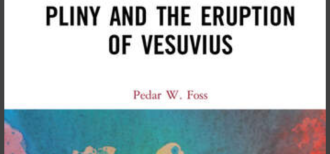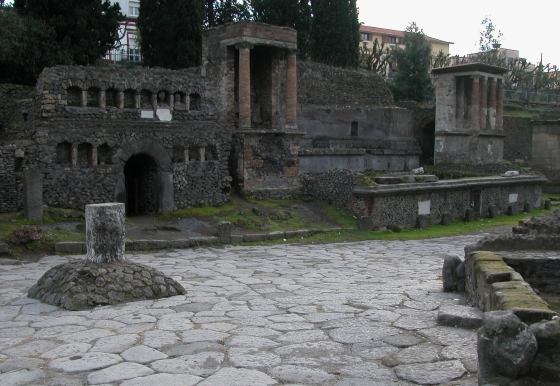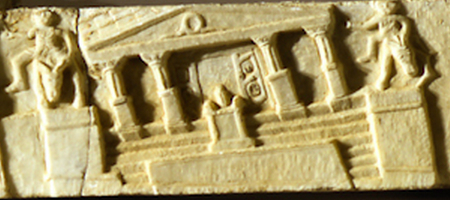Two reviews of Pliny and the Eruption of Vesuvius have come out, one by Margot Neger in BMCR, and one by Paolo Bernardini in La Provincia di Como (here is the PDF and a translation). I should note that the Addenda et Corrigenda on the publisher’s website has also been updated, in order to address the few but unfortunate errors in the text; thank you to colleagues and reviewers for pointing those out.
Category Archives: Pompeii
-
-
Herculaneum Society: Pliny the Younger and the Date and Sequence of the Vesuvian Eruption
Two talks for the Herculaneum Society, based at Oxford, 26 February 2022, now on YouTube:
- Professor Pedar Foss, DePauw University, on “Ashy Tuesday-Wednesday: The Date and Sequence of the AD 79 Eruption;”
- Professor Roy Gibson, Durham University, on “From Como to the Bay of Naples: Pliny’s Epistolary Italy.”
-

The Date of the AD 79 Vesuvius eruption in the textual sources
20-min. lecture from 6 January 2022, Archaeological Institute of America Annual Meeting. All details and data to be published in March 2022: https://www.routledge.com/Pliny-and-the-Eruption-of-Vesuvius/Foss/p/book/9780415705462
Three clarifications/corrections:
1) @ 3:40, when I say that gamma comprises 95% of extant Plinian manuscripts, I should have specified that this was 95% of all extant Plinian manuscripts that contain the Vesuvian letters.
2) @11:20, the date of Biondo’s ms. should be ca. 1424-25.
3) @12:05, I think that mss. c and q have a ‘nou’ with a long macron reading because c° contained both the ‘non’ (with a long macron) from Valla, and also the ‘nou’ from R1472, and either in that ms. or in its descendants, scribes were trying to reconcile those two options. Mss. c and q were both presentation copies (and have a number of errors), so their scribes were just trying to copy in a nice way what they saw in their exemplars, c° and q°. They weren’t necessarily trying to construe ‘November’, though that is a possibility. In either case, ‘November’ was not present in some dusty ancestor. It was contrived first, explicitly, by the r-editor in R1472–} r°.
-
Pliny and the Eruption of Vesuvius – publication March 2022
 Pliny and the Eruption of Vesuvius (Routledge, March 2022) is in press. Here is how to order for your library at a 20% discount. My blog posts about the Vesuvius eruption are well obsolete, but I will leave them as-is for archival purposes. The book is about Letters 6.16 and 6.20, and contains these chapters:
Pliny and the Eruption of Vesuvius (Routledge, March 2022) is in press. Here is how to order for your library at a 20% discount. My blog posts about the Vesuvius eruption are well obsolete, but I will leave them as-is for archival purposes. The book is about Letters 6.16 and 6.20, and contains these chapters:- Two Plinys: Short biographies of the Elder and Younger Pliny, setting the context for the Vesuvian letters.
- Two Letters: A reconstruction of the transmission history of Epp. 6.16 and 6.20 within the context of the whole manuscript tradition of the Epistulae. This is based on the collation of every known and available extant manuscript and early printed edition of the text of those letters (which has never been done before).
- Two Days: A reconstruction—based on the latest volcanological studies and a new complete GIS model of the AD-79 topography of the Bay of Naples—of the eruption sequence, its effects upon the landscape and people of the Bay of Naples, and how those new studies enlighten the accounts in Pliny’s Epistulae, including the likely location of the Pliny’s villa from which the eruption was first spotted. In addition, this chapter treats the date of the eruption, both in the manuscript tradition, and in the archaeological evidence. It shows, among other things, how ‘November’ crept into the manuscript tradition as an error, how that error was propagated, and why the textual tradition cannot be used as a basis for arguing that the eruption happened in October or November, despite the repeated citation of problematic 17th-/18th-c. scholarship and recent press favoring a non-August date.
- Epistulae 6.16, The Elder’s Story: Text, textual variants, new translation, and detailed commentary.
- Epistulae 6.20, The Younger’s Story: Text, textual variants, new translation, and detailed commentary.
Routledge will also host the data files behind the arguments in their Online Resources. Those will include:
- A side-by-side continuous Latin and English translation of Epp. 6.16, 6.20, including the collation markers (PDF).
- Ep. 6.16 Inventory of Sources and Collation (Excel spreadsheet).
- Ep. 6.20 Inventory of Sources and Collation (Excel spreadsheet).
- Epp. 6.16 and 6.20 Collation “Fingerprints” — the key readings that decipher the manuscript tradition (Excel spreadsheet).
- Select Collation of Epp. 1.8, 12, 23-24 — key readings to understand the manuscript tradition for Epp. 1.1-5.6 and the F source (PDF).
- Select Collation of Book 8 Letters — key readings to understand the manuscript tradition for the theta branch of the manuscript tradition (PDF).
- Collation Encoding Key (how manuscript abbreviations in items 2-6 are encoded in the collation spreadsheets) (PDF).
- Continuous Color Diagram for the Manuscript Tradition (PDF).
- Continuous Halftone Diagram of the Eruption Sequence (PDF).
- Geographic Information System (GIS) of the pre-eruption Bay of Naples in AD 79 (ArcGIS folder).
Please cite my work appropriately. Thank you.
-
Translating Pliny’s letters about Vesuvius, pt. 11. The Elements Torn Asunder
6.20.7-9: The Elements Torn Asunder.
This post belongs to a serialized translation and commentary of Pliny the Younger’s letters (6.16 and 6.20) to the historian Tacitus about the eruption of Mount Vesuvius in AD 79. This is the third installment for letter 6.20, and the eleventh overall.
This installment was completed with the contributions of DePauw LAT 223 students Jackson Hicks, Luke Lohrstorfer, and Leigh Plummer in Fall 2014 and 2015.
The Younger Pliny and his mother have been unsettled by strong tremors at their seaside residence early on the morning of the second day of the eruption. The Elder Pliny, who sailed off the afternoon before, is on the Stabian seashore with his friend Pomponianus.
7 Tum demum excedere oppido visum; sequitur vulgus attonitum, quodque in pavore simile prudentiae, alienum consilium suo praefert, ingentique agmine abeuntes premit et impellit.
7. At that point, it finally seemed best to exit the town. A confounded mob followed — and what in fear seems akin to wisdom, each prefers another’s judgement to their own — and in a massive throng it presses and pushes us on as we leave.
Tottering roof tiles have finally forced Younger Pliny, his mother, and their household to abandon their home at Misenum. They are joined by a mob of slaves, freedpersons, and neighbors (vulgus attonitum) who lack, and desire, direction. As he has since 6.20.4, Younger Pliny generates synchronicity—across the bay, at the same time (in letter 6.16.16), Elder Pliny and Pomponianus’ household are also deciding whether to stay or go. In these twin dilemmas, Younger Pliny focuses on the psychological processes of decision-making under stress: Continue reading
-
Translating Pliny’s letters about Vesuvius, pt. 10. When in Doubt, Study

Angela Kauffmann, Pliny the Younger and his Mother at Misenum, 79 A.D. (1785) Princeton University Art Museum (detail; see full painting below)
6.20.4-6: When in Doubt, Study.
This post belongs to a serialized translation and commentary of Pliny the Younger’s letters (6.16 and 6.20) to the historian Tacitus about the eruption of Mount Vesuvius in AD 79. This is the second installment for letter 6.20, and the tenth overall.
This installment was completed with the contributions of DePauw LAT 223 students Jackson Hicks and Leigh Plummer in Fall 2014 and 2015.
At this point in the story, Younger Pliny has spent a restless and bumpy night while his uncle the Elder Pliny has sailed off to investigate the eruption and try to evacuate refugees. He awakens to a dark day.
4 Inrupit cubiculum meum mater; surgebam invicem, si quiesceret excitaturus. Resedimus in area domus, quae mare a tectis modico spatio dividebat.
4 My mother burst into my bedroom at the same time I was getting up, about to rouse her, were she still asleep. We sat down in a courtyard of the house which was separating, by a modest extent, the sea from the buildings.
In the Latin, noteworthy is the mixed conditional with a present-contrary-to-fact imperfect subjunctive (quiesceret) in the protasis, and a future-more-vivid future active participle (exciturus) in the apodosis, all set up by the imperfect of surgebam: “Right then I was in the process of getting up, about to wake [my mom] up (which I was definitely going to do), if she were [still] sleeping (which she wasn’t).” In the second sentence, the relative clause (area…quae) is straightforward.
The first line is dotted with adrenaline vocabulary (inrupit, surgebam, excitaturus) that perks up the reader at the same time that the story’s main characters (Pliny and his mother) are waking up during the night to find each other out of mutual concern. There is a running theme in this letter about the anxiety of separation. Uncle Pliny is away (and at about this time in letter 6.16, also being roused [excitatus]); he “left behind” Young Pliny (relictus, from 6.20.1). Can mother and son stay together as the volcanic storm descends upon them?
-
ROMARCH: Liverpool Research Day: Pompeii

MEDITERRANEAN ARCHAEOLOGY RESEARCH DAYPompeii
POSTPONED
(further information will be posted when it becomes available)Saturday 15th February 2014The Gallery, Foresight Centre, University of Liverpool
Pompeii is the most iconic city of the ancient world and has come to stand as a symbol for the ancient world in the popular imagination and contemporary media. However, there is still much that we do not fully understand about this most famous of archaeological sites and exciting new research directions are taking seek to contextualise our understanding of Pompeii as a living community within its contemporary Roman context as well as an enduring emblem of the achievement of Roman culture and the destructive power of nature.
Aimed at researchers, learners and the general public, this day consists of lively illustrated lectures on all aspects by leading international researchers on their latest research into ancient Pompeii and modern perceptions of the city and its cultural legacy. Papers cover aspects of history, archaeology, geology and the reception of Pompeii by contemporary societies. There will also be a hands-on demonstration of Roman artefacts during the break.
To book a place online go to: http://payments.liv.ac.uk/browse/extra_info.asp?compid=1&modid=2&deptid=38&catid=45&prodid=190
<see below for the full programme>
-
Translating Pliny’s letters about Vesuvius, pt. 9. Shuddering to Remember

The world turned topsy-turvy: detail of a relief from Pompeii depicting the earthquake of AD 62/3 toppling the Temple of Jupiter (see below for details)
6.20.1-3: Shuddering to Remember
This post belongs to a serialized translation and commentary of Pliny the Younger’s letters (6.16 and 6.20) to the historian Tacitus about the eruption of Mount Vesuvius in AD 79. This is the first installment for letter 6.20, and the ninth overall.
I provide the Latin (using Mynors’ 1963 Oxford Classical Text [OCT]), and then work through it with a translation, dissection of grammatical constructions, and discussion of what the letters tell us. Other pages in the series detail the manuscript tradition and the cast of characters in the two letters. The Codex Laurentianus Mediceus for letter 6.20 can be viewed here Plut. 47.36, p. 186.
The Latin is in italics; English translation follows in Roman text, indented, and then commentary in brown text. Parentheses indicate (‘understood’) words that are not explicit in the Latin. My purpose here is as much to look at the process of translating as to provide another translated product. So I tend to err on the side of a technical rather than a fluid English translation.
The Younger Pliny has already written one account of the eruption (6.16) in order to describe the death of his uncle, Pliny the Elder. He now pens a follow-on to Cornelius Tacitus about his own, and his mother’s, flight from the volcanic storm.
C. PLINIUS TACITO SUO S.
Gaius Plinius greets his dear (friend) Tacitus.
‘C‘ is the abbreviation for the common name ‘Caius‘, or ‘Gaius‘. ‘S‘ is short for ‘salutem‘, and goes with the gapped verb ‘dicit‘ to mean ‘says greeting’. ‘Suo‘ is a term of affectionate familiarity often used to denote ‘one’s own’ (i.e., family and friends) This address is identical to that of 6.16.
1 Ais te adductum litteris quas exigenti tibi de morte avunculi mei scripsi, cupere cognoscere, quos ego Miseni relictus (id enim ingressus abruperam) non solum metus verum etiam casus pertulerim. ‘Quamquam animus meminisse horret, …incipiam.’

